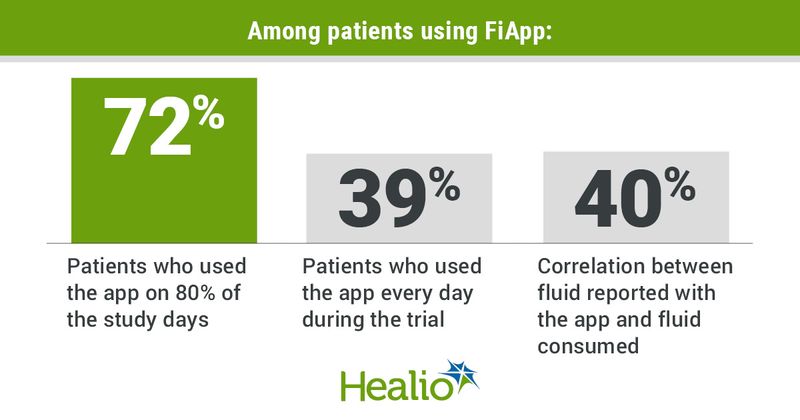Mobile app may help patients on hemodialysis regulate fluid intake
Key takeaways:
- Weight gain averaged 5.7 pounds at baseline and 5.6 pounds using FiApp.
- Thirty-nine percent of patients used the app every day during the study.
A smartphone-based application may help patients receiving maintenance hemodialysis safely and effectively regulate their fluid intake, researchers found in a newly published study.
Participants in the pilot study lowered their interdialytic weight gain (IDWG) despite having a baseline IDWG lower than 4% of body weight, according to the findings.

"IDWG has been associated with increased morbidity and mortality,” Michael V. Rocco, MD, MSCE, of the nephrology section at Wake Forest School of Medicine in Winston-Salem, North Carolina, and colleagues, wrote. “We evaluated the usefulness and safety of a mobile application that allows [patients] to self-monitor their daily fluid intake.”
Eighteen patients on maintenance hemodialysis with a mean IDWG less than 4% completed the 4-week study in 2019. A nephrologist coached participants on how to use the iOS and Android-capable FiApp (developed by FIAP), which allowed them to record fluid intake and compare it to their targeted daily fluid intake. Patients recorded fluid intake data each day for 4 weeks through the app. Patients dialyzed three times per week, and body weight was recorded by standard dialysis policy before and after each dialysis session to calculate IDWG.
Participants completed a qualitative survey in weeks 1 and 4 and provided all app data at the end of the trial. Researchers compared data before and after the course. Primary outcome was the association between IDWG and fluid intake recorded using the app.
Results indicated that the mean 4-week IDWG during app use was similar to the baseline mean 4-week IDWG before using the app. However, 61% of participants experienced a decrease in IDWG using the app compared with baseline. Of the 18 participants who completed the study, one had a mean 4-week IDWG 20% higher than at baseline.
Weight gain averaged 5.7 pounds at baseline and 5.6 pounds using the app. In the interdialytic period, the percentage gain in body weight was 2.9% at baseline and 2.8% using the app, ranging from 1.2% to 4.4% and 1.1% to 5.2%, respectively, at baseline.
Overall, 72% of patients used the app on 80% of the days, and 39% used it every day. There was a 40% correlation between fluid reported using the app and fluid consumed.
While the study had some limitations, such as recruiting patients with a relatively lower IDWG percentage, the app received mostly positive feedback, according to the researchers.
“Overall, the app was considered easy to use and appreciated for its simplicity and user-friendly interface,” they wrote. “Preliminary data suggests that the app is effective in a majority of patients in decreasing IDWG.”
